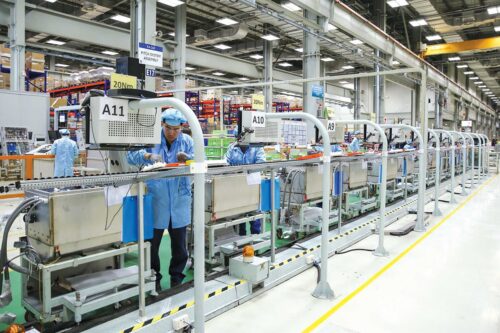By Đinh Hồng Kỳ – Doanh Nhân Sài Gòn Online, August 12, 2025

Ho Chi Minh City’s international financial center (IFC), recently approved by the National Assembly, is expected to become the “gateway” for Vietnam to integrate more deeply into global capital markets. However, an IFC that functions solely as a place for financial transactions will quickly become outdated.
Integrating green finance into the IFC
In a world entering the post-carbon era—where ESG and green finance have become mandatory standards for capital flows—the overarching concept of financial activities serving environmental goals is paramount. This includes financing projects for energy efficiency, renewable energy, sustainable transportation, smart cities, and climate risk management, all in line with green finance criteria.
Globally, major stock exchanges have already established ESG indices, green bonds have become a key fundraising channel, and financial institutions are restructuring investment portfolios toward net-zero emissions.
If Ho Chi Minh City wants to compete with centers like Singapore and Shanghai, it must develop a green finance model. This is the most feasible and suitable path to differentiate the city’s IFC.
Key solution groups to make green finance the “soul” of the Ho Chi Minh City International Financial Center include:
First, the city should develop its own set of green finance standards compatible with the EU Taxonomy and other international benchmarks, while adapted to Vietnam’s realities. This standard set will serve as the basis for licensing, supervising, and assessing financial institutions within the center. Additionally, a Ho Chi Minh City Green Finance Development Council should be established, consisting of representatives from government, banks, businesses, and experts, tasked with policy advice and ESG oversight.
Second, invest in green finance data infrastructure, including ESG credit scoring systems, carbon indices for listed companies, and mandatory disclosure platforms. Building a carbon trading exchange should be prioritized, serving as a crucial tool to connect enterprises with the emissions offset market.

Ngoài những chính sách chung như miễn thuế thu nhập cá nhân cho chuyên gia nước ngoài hay thuế TNDN 10% trong 30 năm, TP.HCM nên triển khai thêm các ưu đãi chuyên biệt như miễn thuế phát hành trái phiếu xanh, trợ cấp lãi suất cho tín dụng xanh, hoặc cơ chế bảo lãnh cho các khoản vay phục vụ chuyển đổi năng lượng và kinh tế tuần hoàn nhằm tạo động lực để các tổ chức tài chính trong và ngoài nước chọn TP.HCM là nơi triển khai các sản phẩm đầu tư bền vững.
Regional linkages as a foundation
Former Binh Duong, with nearly USD 44 billion in FDI, is an ideal place to develop corporate green finance, circular trade credit, and ESG transition consulting services for industrial plants. Meanwhile, former Ba Ria–Vung Tau, Vietnam’s energy hub, has strong demand for climate risk insurance, financing for hydrogen projects, and offshore wind power—fields perfectly suited to green finance mechanisms.
A “regional green finance zone” model connecting multiple sub-centers would help reduce pressure on Thu Thiem while fully leveraging each area’s economic strengths.
Learning from Shanghai and Singapore—two of the region’s largest IFCs—shows that the core factor is not transaction volume, but the ability to create sustainable value and lead new standards. Shanghai has succeeded with its FTZ offering strong incentives for carbon trading, while Singapore has become a Fintech Hub with the largest ESG capital inflows in Southeast Asia.
Ho Chi Minh City can learn from them, but should not simply copy. Its unique path is green finance—a sector where the city has both domestic demand and strong support from the Government. If carefully and consistently designed, the Ho Chi Minh City International Financial Center could become ASEAN’s first responsible financial center, meeting the world’s post-carbon sustainable development expectations.
(*) Chairman of Secoin Corporation, Chairman of the Ho Chi Minh City Green Business Association (HGBA)
Original article link on Doanh Nhân Sài Gòn Online: https://doanhnhansaigon.vn/de-tp-hcm-la-trung-tam-tai-chinh-co-trach-nhiem-dau-tien-cua-asean-bai-3-321080.html


